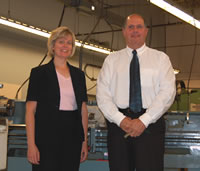 A teamwork approach to skills training in North Bay is strengthening the city’s mining supply sector.
A teamwork approach to skills training in North Bay is strengthening the city’s mining supply sector.
With an ominous forecast that the Canadian mining sector will experience a complete turnover of its workforce in 10 years requiring 92,000 positions to be filled, Canadore College is collaborating with the city’s economic development department and mining suppliers to meet the skilled labour needs of local companies.
Despite the fact that North Bay has no physical mines, it is home to approximately 65 businesses that provide mining supplies and exploration and mine development services. Canadore provides a number of trades-related programs that have grown exponentially during the last eight years.
About seven or eight years ago, there were only 200 students at the Commerce campus where the skilled trades are taught, said Darrin Caron, dean of trades. “The trades programs were all undersubscribed and there was talk of shutting down the trades program because of financial pressures.”
However, the college’s president, Barbara Taylor, pushed to keep the program’s doors open. Now there are 1,100 students at the Commerce campus, the majority being students in the trades program.
“We are bursting at the seams,” Caron said. “Our trades-related apprenticeship numbers have increased over the last two years, and Canadore has introduced three new apprenticeship programs in the last three years.”
Skilled trades program options
Canadore provides two options in its trades department: a two-year technician diploma program and a one-year techniques program. Caron said the two-year diploma programs are accelerated, so that they run from September through to August, compressing two years into one.
“We do theory hands-on. We know our business as applied learners and know how to make it work.”
A shorter, more intense academic year results in a reduced cost of living for students. It also allows them to get out and earn money sooner, making it an attractive model.
The day release option within the apprenticeship programs is another example of a solution that evolved from working with local companies. Traditionally, apprenticeship programs ran in eight-week blocks, during which students spent their academic time at the college. The day release means the apprentices upgrade their skills at the college one afternoon a week on Fridays from 1:30 p.m. to 7:30 p.m. over a 40-week period.
“It enables employers to keep producing and gives the students a chance to apply what they’ve done the day before,” Caron said.
It’s a win-win situation for both employer and apprentice. With the exception of the autobody and marine and small engines programs, all of the apprenticeship programs are structured for day release.
As an institution of applied learning, the college is mandated to have program advisory committees made up of industry representatives. The advisory committees offer input that impacts directly on the program.
“The mining companies do have a say in our curriculum,” Caron explained. “We are connected with the curriculum and graduates through those program advisory committees. They tell us what they like about our programs and what needs changing.”
Recruitment strategies
Recruitment events are held to help educate elementary and secondary students and their parents about the various opportunities in mining and related services.
Events such as Mining Week and Explore the Trades Day are examples of coordinated efforts by industry and the education sector to inform youth about future mining career prospects.
Tracie Marsh-Fior, director of continuing education and part-time studies and an active member of the local Canadian Institute of Mining, Metallurgy and Petroleum (CIM) executive, said the North Bay chapter has key industry players like Cementation, Atlas Copco, J. S. Redpath and Sandvik.
“They are involved in every level of education and are cognizant of getting the youth educated about mining sector jobs to break down the preconceived notions,” Marsh-Fior said. “Everyone is involved: economic development, industry and education. We have to increase the piece of the pie and the only way to do this is through collaboration.”
Labour Market Initiative
Marsh-Fior has been involved in a two-year Labour Market Initiative. Sponsored in partnership with the city, the Mayor’s Office of Economic Development, Canadore College, Nipissing University, Employment Ontario, the Chamber of Commerce and the provincial and federal governments, the study is conducting an intensive survey of all the sectors within the city to determine the long-range labour force needs for the region. The first of its kind in Canada, the study is detailed in terms of both scope and acquisition of employer/employee information. Rick Evans, Manager of the Mayor’s Office of Economic Development, said the initiative was in response to a previous Business, Retention and Expansion program that surveyed more than 230 companies several years ago.
“One of the top issues identified in both the private and public sectors was access to skilled labour as a barrier to growth,” Evans said.
Consequently, a date-of-birth specific survey was initiated using the National Occupation Code (NOC) to fill the gaps in an education system that has traditionally designed curriculum based upon dated census data or reacted to labour market demands through its continuing education program. Evans said that gathering information in every NOC category will indicate what skill sets and academic requirements are needed.
“We needed that because it enables us to develop the teaching aids and marketing pieces,” Evans said.
The study will provide accurate 10 to 15 year labour market projections.
Marsh-Fior said it will result in a complete analysis of the region’s labour market needs.
“From a college perspective, this information will help us identify areas of concern that we can address in the short and long term,” she said.
The five-year lead time will give the College the time it needs to plan for growth, to acquire instructors and equipment and develop recruitment strategies.


